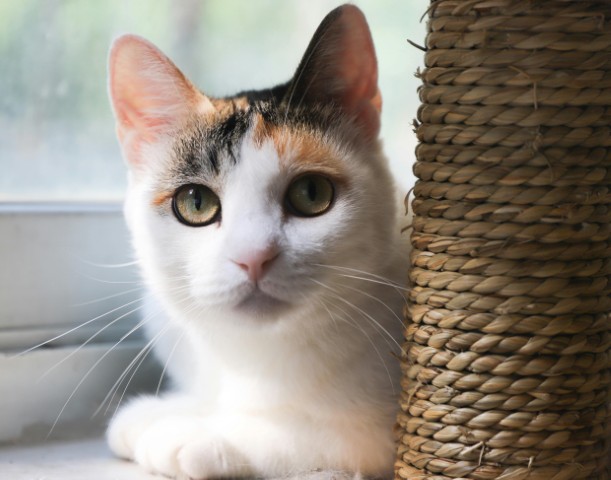Cats use what feels safe, interesting, and easy to reach. If a tree lives in a dead corner or wobbly spot, most cats will ignore it. Use this guide to place your tree where your cat wants to hang out—so climbing becomes the obvious choice.
Safety & Liability Disclaimer:
These tips are general guidance. Your walls, tools, and cats are unique, please use your best judgment and follow manufacturer instructions. Proceed at your own risk. If anything feels, looks, smells, or sounds unsafe, stop and consult a qualified professional. Cat Climbing Structures can’t accept responsibility for damage or injury from how this information is used.
Table of Contents
Why Placement Matters
A good spot does three things. It:
- feels safe (stable base, predictable landings)
- pays off (view of people or window action)
- fits the routine (near places your cat already loves).
When those align, the “new tree” becomes their spot in days, not weeks.
For deeper context on enrichment and vertical territory, see the below resources on Why Cats Need to Climb & Related Info.
- Best Cat Climbing Structures [For ALL Cats]
- Things Cats Climb That Are Important For A Healthy Lifestyle
- Why Do Cats Like To Climb To High Places? [5 Reasons]
- Providing The Best Cat Climbing Structures for Kittens
Choose The Right Room First
Pick a room your cat already claims, usually the living room, home office, or a bedroom window zone. If your cat avoids a room now, the tree won’t magically fix that.
Start where they already nap, watch, or follow you.
For tight spaces, the items below link to space-smart solutions:
• Best Cat Trees For Small Apartments
Corner Vs. Flat Wall (And How Far From The Corner)

Corners are stability gift-wrap in that the two walls reduce sway and help cats feel protected. Place the base so two sides touch the walls (or at least one wall if a true corner isn’t possible).
Flat wall placement works if the base is wide and the floor is grippy. Leave 6–12 in (15–30 cm) between the back of the tree and the wall to prevent thumps and give tails room.
If there’s still wobble after placement, the items below link to quick fixes:
• Cat Tree Stability Tips
Windows & Sunlight (The “Payoff View”)
Most cats love a view. Place the tree near a window your cat already watches, but avoid long stretches of direct, hot sun on plush perches in summer.
In winter, that warm patch can sell the spot instantly. If you open windows, ensure screens are secure and the tree can’t push into them.
Traffic Flow & Approach Routes
Make the first step easy. No leaping over baskets or squeezing behind chairs to get on. in other words, make sure they have a:
- Clear runway: leave a 2–3 ft (60–90 cm) approach path to the lowest perch so the “start” is obvious.
- Two routes for multi-cat homes: where possible, allow up and down on different sides to reduce “stairway standoffs.”
- Quiet landing zones: keep the area under the bottom perch uncluttered; add a small grip rug where paws land.
Landing Zones & Floor Types
Where paws land matters as much as where paws start. The following can make all the difference:
- Hardwood/Tile: add a non-slip underlay under the base and a small rug in front for traction.
- Plush Carpet: choose a wider base or place a thin plywood platform under the base to spread weight and reduce wobble.
- Near Doorways: keep at least 3 ft / 1 m from doors that swing open so surprises don’t spook a climber.
Multi-Cat Harmony (Keep The Peace)
Stacked territory can calm tension if everyone has options.
- Equal-height perches: offer two similar-height spots so one cat doesn’t own the only penthouse.
- Parallel resources: keep a second scratcher or another tree in the same room so nobody queues at one post.
- Sightlines: angle the tree so a cat on a high perch sees the room without being ambushed from behind.
Room-By-Room Ideas
- Living Room: corner near a window or where family gathers since cats want to be in the action.
- Home Office: behind your chair or beside the desk; trade keyboard-sitting for perch-sitting.
- Bedroom: window corner for morning sun; keep nightstands clear so 2 a.m. zoomies don’t end in chaos.
- Studio / Small Apartment: use a slim, tall tree or a wall-mounted system to save floor space.
• Space-Saving Picks
• Best Wall-Mounted Cat Climbing Systems
Troubleshooting Placement (When A Cat Ignores The Tree)

If the spot is right but interest is low, layer in encouragement.
- Make the tree pay off: end short play sessions on the tree, place a single treat on the lowest perch, or time sessions with sun-patch hours.
- Match texture: if your cat is a horizontal scratcher, place a low scratcher next to the tree, then redirect to the vertical sisal post over a few days.
- Fix wobble first: cats won’t climb if it feels sketchy so address grip and level before training.
For a full routine, the item below links to a complete guide:
• Train Your Cat To Use A Cat Tree (Quick Start)
Monthly 2-Minute Placement Check
Tiny, regular checks keep everything quiet and safe.
- Wobble test: gentle push from each side—still solid?
- Base & pads: still grippy and flat; replace if slick.
- Room shifts: new furniture or curtains blocking the runway? Re-open the path.
If your tree is tall or your cat is very athletic, consider discreet wall anchors once the location is set:
• Wall Anchors For Tall Cat Trees
FAQs
How close should a tree be to a window?
Close enough to enjoy the view, not so close that opening the window pushes the tree or stresses the screen. A few inches of space and a snug base keep things calm.
Is the bedroom a bad idea?
Not at all. Many cats love a bedtime perch. Choose lower perches for quieter nights and ensure the landing zone isn’t your nightstand.
What if my cat prefers the couch arm for scratching?
Block the couch briefly (double-sided tape or a throw) and prime the sisal post by lightly rubbing catnip/silvervine and scratch it with your nails to make the sound. Reward the first scratch on the tree.
How many trees for two cats?
Start with one well-placed tree plus a secondary scratcher. If guarding continues, add a second tree or a wall route on another wall to split traffic.
Keep Learning
Want to learn more about creating a healthy climbing environment for your cat? Checkout these resources for deeper understanding into your feline’s unique needs when indors:
- Make Any Cat Tree Safer & More Stable — quick fixes for wobble and slide
- Train Your Cat To Use A Cat Tree (Quick Start) — positive steps that build a habit
- Wall Anchors For Tall Cat Trees — when you need them and how to install